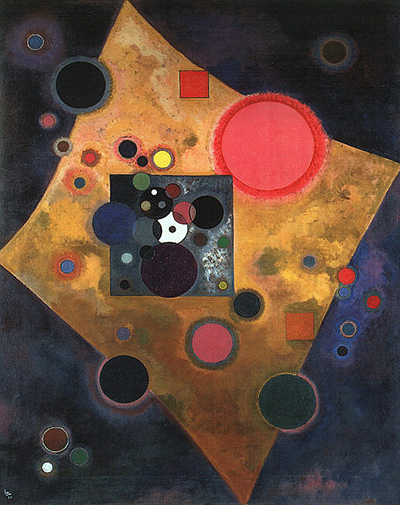Kandinsky is famous for his combinations of circles and squares, with Accent en Rose arriving in 1926. Color Study: Squares with Concentric Circles remains his best known geomertic work, and is often used today to attract children into art.
Since it's inception, it has sometimes been translated into Accent in Rose or Accent in Pink. The artist was working at a rapid pace during the late 1920s and these types of geometrical combinations appeared again and again. The red circle dominates your eye initially, before your focus moves across to the series of smaller circles as well as a number of larger squares and rhombuses. Tones of yellow are used to allow the vibrant red to stand out even more, whilst the rest of the painting is darker and more subdued.
The placement and sizing of each shape appears random, though Kandinsky would certainly have put plenty of thought and planning into this piece. Typically, these geometric works were worked through in study sketches prior to the oil piece being commenced. Most shapes overlap at least another. The background colours are gradients, giving us an overall feeling that we are staring into the cosmos, with unidentifiable planets strewn together as a result of natural activities over many millions of years.
The painting was completed in Dessau, just around the time that Wassily turned 60. By this time his career was flying high, with even the Bauhaus movement offering considerable coverage of his achievements up to that point. The artist later discussed Accent en Rose, plus a number of other similar artworks, and placed an importance in contrasting the clear, designated shapes with the other parts of the composition which were blurred, almost gas-like. It can be hard to understand the explanations around some abstract pieces, but many can still appreciate the artist's paintings from purely an aesthetic point of view, even without an interest in the theories behind it. It is interesting to witness how art history continues to develop and evolve, often accepting new artistic styles eventually, having rejected them for several decades initially. The public can also follow a similar path in terms of their own taste.




